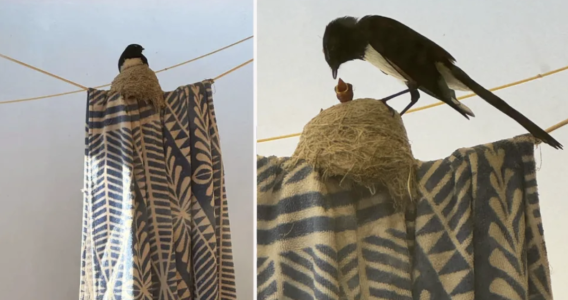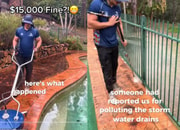Aussie Woman's Bizarre Backyard Discovery Has Everyone Begging for Answers – See Why It's Driving Australians Wild!
By
Seia Ibanez
- Replies 25
In the land down under, where the wildlife is as diverse as the landscape, Australians are no strangers to the odd and the extraordinary. But even the most seasoned Aussie can be taken aback by the surprises Mother Nature has up her sleeve, as one woman recently discovered in her own backyard.
After returning from a two-week holiday, the woman was greeted not by the usual tranquility of her garden, but by an astonishing sight: a bird nest precariously perched atop her washing line, cradling a family of willie wagtails. The nest, which had been built on a towel she'd left out to dry before her departure, was now home to a diligent mother bird and her chicks.
The discovery quickly turned from wonder to worry when the woman noticed the nest beginning to tilt dangerously. With one chick already having met a tragic fate after falling out, she faced a dilemma: should she risk moving the nest and potentially provoke the protective parent birds, or leave it be and hope for the best?

Taking to social media to seek advice, the woman's story captured the attention of Australians nationwide, with many expressing disbelief at the bird's unconventional choice of nesting site. 'This is the craziest nest ever,' exclaimed one commenter, echoing the sentiment of many.
But according to Sean Dooley, an urban bird expert at Birdlife Australia, the willie wagtail's decision to nest on a washing line might not be as crazy as it seems. 'We might think that birds make dumb choices as to their nesting site, but it's a big decision for them, and they weigh up a lot of factors,' Dooley explained to Yahoo News.
He suggested that the mother bird might have chosen the location for its perceived safety from predators, thanks to the constant human presence. The swinging motion of the clothesline, he pointed out, is not unlike the natural sway of tree branches where willie wagtails typically nest.
Despite the high mortality rate among young birds, with success being the survival of just one chick from a clutch of three or four, Dooley advised against moving the nest. Interfering could disrupt the birds' natural behavior and even lead to aggressive displays from the parents, who are known to fiercely protect their young.
In a heartwarming turn, the woman managed to fashion a makeshift hammock with the towel to provide additional support for the nest, ultimately deciding to respect the bird's claim to the spot. 'By that stage, I decided she now had ownership,' she humorously conceded.
The tale of the willie wagtail's urban adaptation is a reminder of the resilience of Australia's wildlife. However, Dooley noted that while willie wagtails have historically thrived in urban settings, their numbers have been declining, possibly due to competition from the increasingly populous noisy miner, a native honeyeater.
This backyard saga is just one of the many stories that showcase Australia's unique and fascinating environment. From the curious behavior of urban birds to the broader challenges facing wildlife in changing landscapes, there's always something to learn and marvel at in this great southern land.

So, dear readers, have you ever encountered an unexpected wildlife encounter in your own backyard? What did you do, and how did it turn out? Share your stories with us, and let's celebrate the weird and wonderful world of Australian nature together.
After returning from a two-week holiday, the woman was greeted not by the usual tranquility of her garden, but by an astonishing sight: a bird nest precariously perched atop her washing line, cradling a family of willie wagtails. The nest, which had been built on a towel she'd left out to dry before her departure, was now home to a diligent mother bird and her chicks.
The discovery quickly turned from wonder to worry when the woman noticed the nest beginning to tilt dangerously. With one chick already having met a tragic fate after falling out, she faced a dilemma: should she risk moving the nest and potentially provoke the protective parent birds, or leave it be and hope for the best?

A woman came home to a bird that had created a nest on her clothesline. Credit: u/alwayslate6 / Reddit
Taking to social media to seek advice, the woman's story captured the attention of Australians nationwide, with many expressing disbelief at the bird's unconventional choice of nesting site. 'This is the craziest nest ever,' exclaimed one commenter, echoing the sentiment of many.
But according to Sean Dooley, an urban bird expert at Birdlife Australia, the willie wagtail's decision to nest on a washing line might not be as crazy as it seems. 'We might think that birds make dumb choices as to their nesting site, but it's a big decision for them, and they weigh up a lot of factors,' Dooley explained to Yahoo News.
He suggested that the mother bird might have chosen the location for its perceived safety from predators, thanks to the constant human presence. The swinging motion of the clothesline, he pointed out, is not unlike the natural sway of tree branches where willie wagtails typically nest.
Despite the high mortality rate among young birds, with success being the survival of just one chick from a clutch of three or four, Dooley advised against moving the nest. Interfering could disrupt the birds' natural behavior and even lead to aggressive displays from the parents, who are known to fiercely protect their young.
In a heartwarming turn, the woman managed to fashion a makeshift hammock with the towel to provide additional support for the nest, ultimately deciding to respect the bird's claim to the spot. 'By that stage, I decided she now had ownership,' she humorously conceded.
The tale of the willie wagtail's urban adaptation is a reminder of the resilience of Australia's wildlife. However, Dooley noted that while willie wagtails have historically thrived in urban settings, their numbers have been declining, possibly due to competition from the increasingly populous noisy miner, a native honeyeater.
This backyard saga is just one of the many stories that showcase Australia's unique and fascinating environment. From the curious behavior of urban birds to the broader challenges facing wildlife in changing landscapes, there's always something to learn and marvel at in this great southern land.
Key Takeaways
- A woman found a bird nest built on her washing line by a willie wagtail after returning from holiday.
- Concerns were raised for the nest’s stability and the safety of the chicks, with one chick already having fallen out and died.
- Urban bird expert, Sean Dooley, explained that birds often consider many factors when choosing a nesting site and that the mother bird likely had her reasons for choosing such an unusual location.
- Despite the decline in willie wagtail numbers, it is advised to leave the nest undisturbed to avoid interfering with the birds and to reduce the risk of being swooped.
So, dear readers, have you ever encountered an unexpected wildlife encounter in your own backyard? What did you do, and how did it turn out? Share your stories with us, and let's celebrate the weird and wonderful world of Australian nature together.







